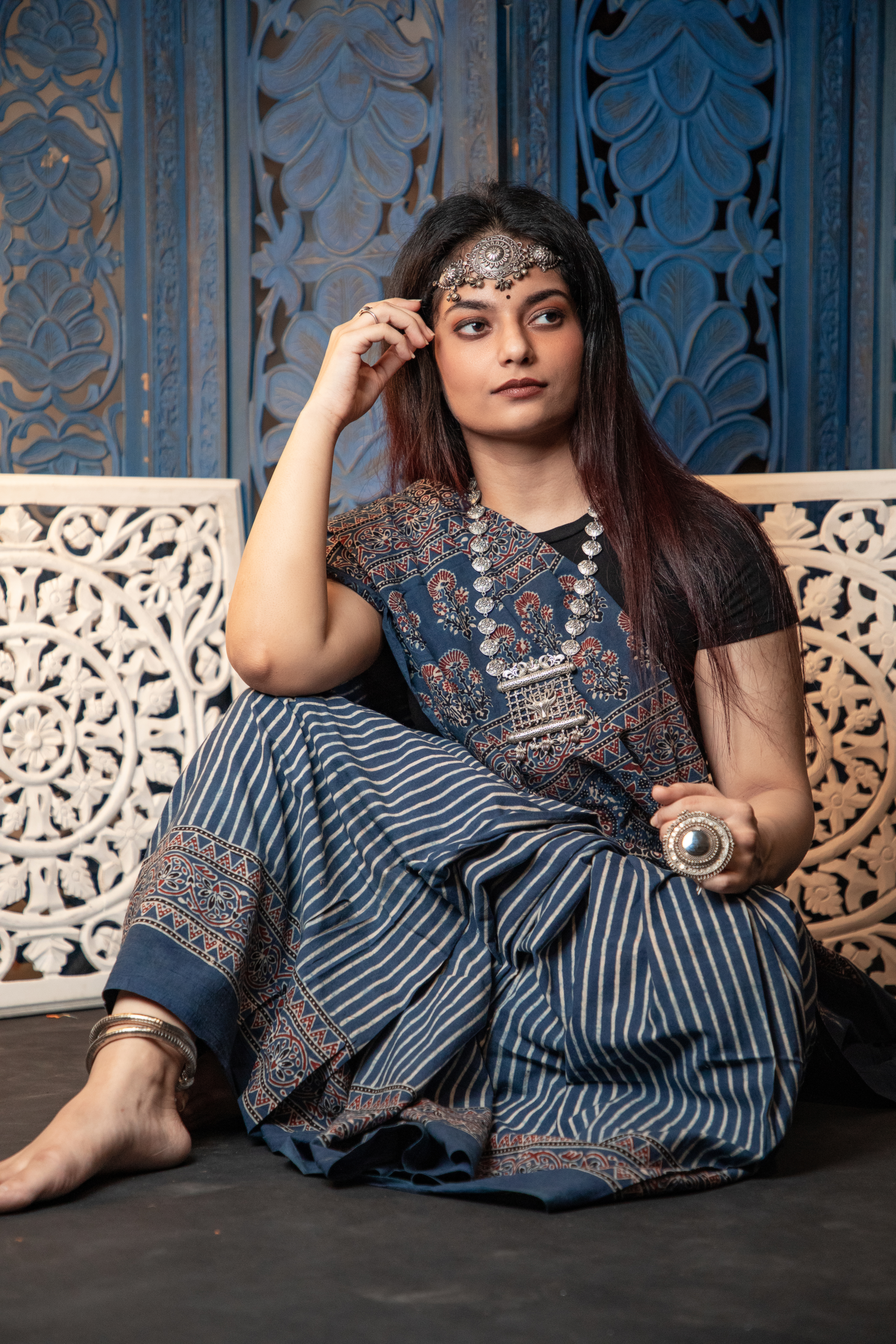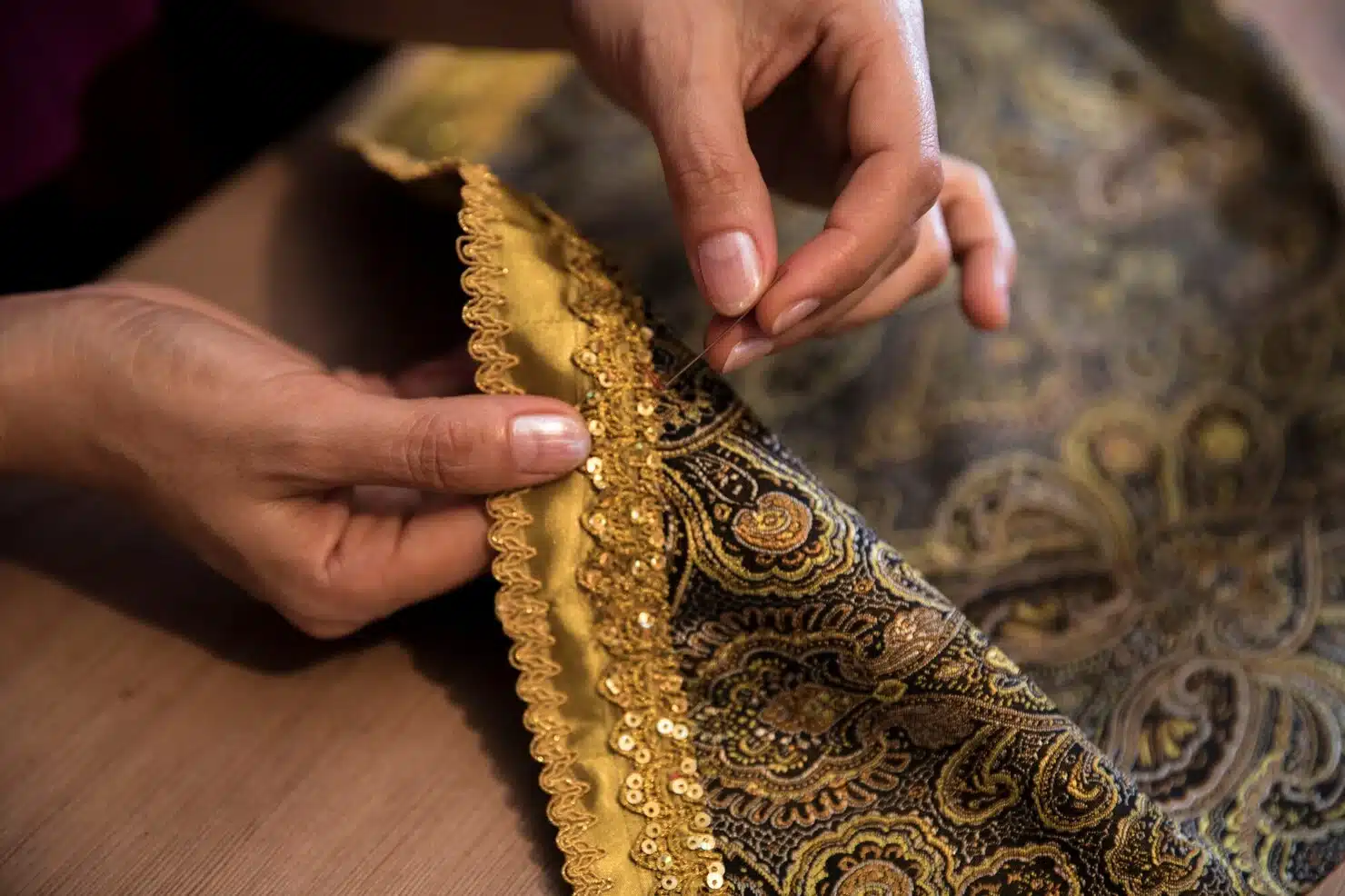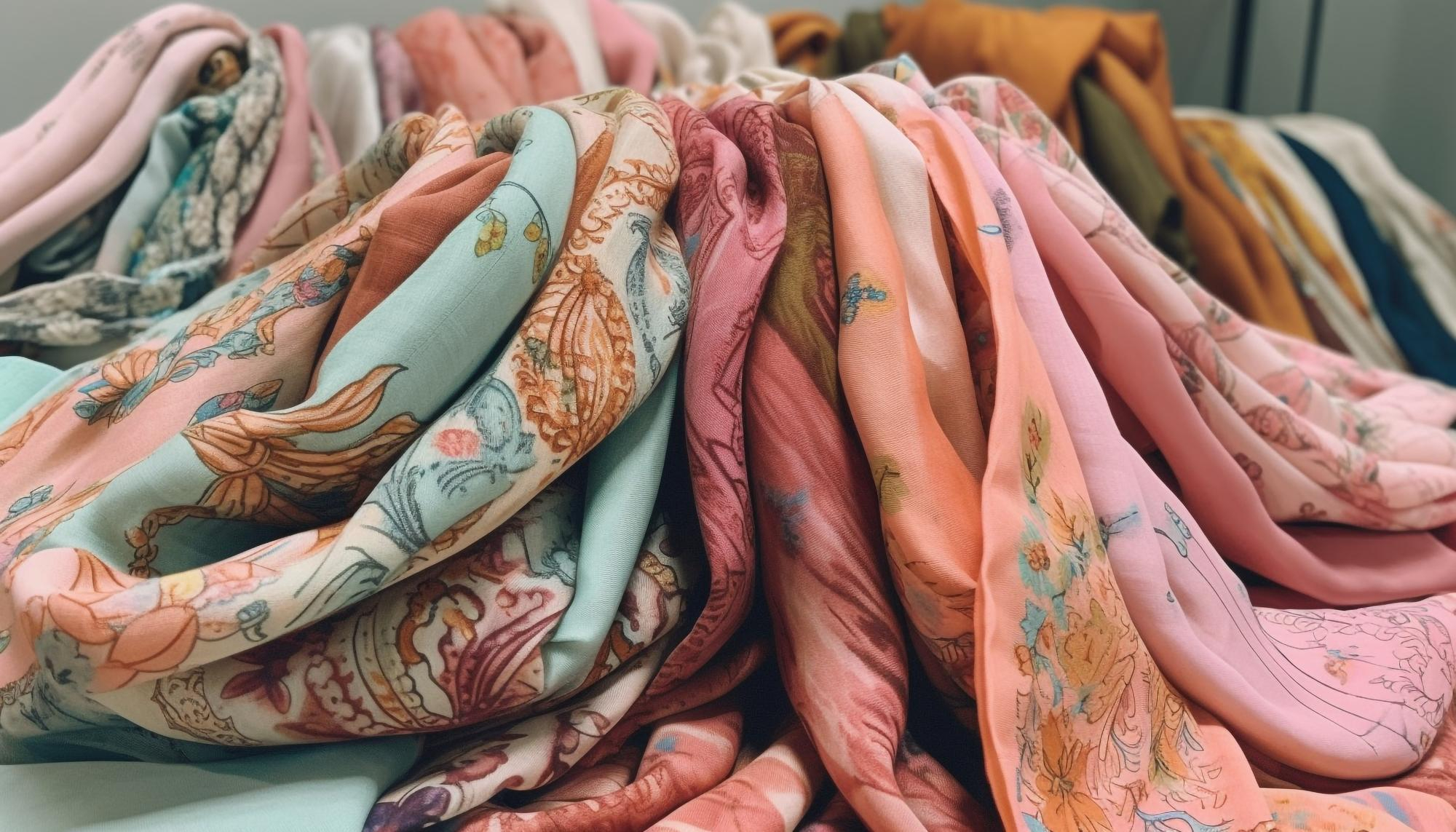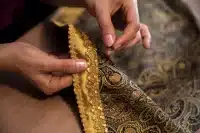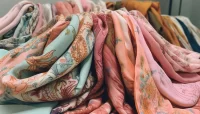Narayanpet sarees are a visual poetry, an ode to the craftsmanship that has been honed and perfected over centuries. What distinguishes these sarees is a meticulous attention to detail—obsession with vegetable dyes, trademark checks in the self-color weave, and wide golden zari borders at both ends of the fabric. The Narayanpet saree is further characterized by a double shimmer quality, a result of its unique weaving process.
The weavers of Narayanpet take pride in producing sarees of exceptional quality. The use of quality materials and fine counts of weave ensures not only durability but also a lasting shine that becomes a hallmark of Narayanpet Pattu sarees. Interestingly, each saree from Narayanpet incorporates a temple design in contrast color to the background, symbolizing the blessings of the local goddess. Triangles in series form a border, running parallel to another contrasting border, adding a distinctive touch to every saree woven in Narayanpet.
History and Origin
To truly appreciate the beauty of Narayanpet sarees, one must delve into their fascinating history. The year was 1630 AD when Chattrapati Shivaji Maharaj, the revered Marathi emperor, found himself in the Narayanpet region during his travels. Setting up camp, he observed a few specimens of sarees that caught his attention. Intrigued, he left behind a few weavers from his army with the task of replicating the finesse of those fabrics.
As Shivaji continued his journey, the chosen weavers decided to stay and continue what they had started. Thus, the legacy of Narayanpet sarees was born—a tradition that has endured for centuries without losing its luster. These weavers found not just a livelihood but a passion in their craft. The sarees they produced gained a reputation as fine as the fabric itself, becoming offerings to the local deity for the positive change they brought to the lives of those who wove them.
Over time, Narayanpet Pattu sarees witnessed inclusions and changes, with new designs and combinations keeping the tradition alive and acknowledged across the land. The fine counts of 80:80, vibrant colors, continued luster, and the interlocked weft weave all contribute to the saga of Narayanpet, weaving tales of tradition and excellence.
Narayanpet Sarees Designs & Weaving Process
The journey of a Narayanpet saree begins with a meticulous process of washing and drying. The first step involves degumming or separating gum from the natural yarn by dipping it in boiling water. The yarn is then bleached, losing its natural color to readily acquire the vibrant hues of vegetable dyes. The stirring in the vat during the boiling process ensures uniform color on the yarn.
After being washed again and dried in the shade to retain color fastness, the yarn is spun into threads. These threads are then laid out on the warp for the length-wise lay and rolled onto small sticks for the breadth-wise weaving or weft. To make the process economical, threads for at least 15 sarees are loaded onto a charkha or wheel before being carefully stretched onto the longitudinal framework.
The uniqueness of Narayanpet handloom sarees lies in the interlocked weft technique, which involves weaving two different-colored wefts side by side without creating gaps. Though slightly tedious, this method creates a homogeneous design with a seamless blend of colors. The jacquard attachment, though optional, is often used to add mesmerizing designs to the Narayanpet fabric.
When it comes to weaving a block of color, a straight weave block might create gaps. However, the Narayanpet Pattu sarees employs the dovetail join and interlocking weft methods to ensure two different-colored wefts sit side by side without any gaps, adding to the allure of the saree.
Varieties of Narayanpet Sari
Narayanpet sarees come in a rich variety, each with its distinctive appearance and charm. The silk and cotton Narayanpet sarees, woven in deep earth tones, feature a checkered surface with intricate embroidery and ethnic patterns, often depicting temple motifs on the border or pallu. The introduction of Narayanpet Silk sarees has elevated the artistry, offering exquisite and luxurious options that are both visually appealing and comfortable to wear throughout the year.
The sarees from this region showcase a harmonious blend of Telangana and Maratha styles, illustrating how the fusion of different cultures results in variations that are aesthetically pleasing. Narayanpet Silk sarees share similarities, including a lightweight feel, a unique contrast border, and delicate zari motifs on the borders, adding an extra layer of sophistication to the traditional craft.
How to Identify Authentic Narayanpet Saree
For those keen on owning an authentic Narayanpet saree, it’s essential to be able to distinguish the genuine ones from imitations. Here are some key features to look for when identifying authentic Narayanpet Cotton Sarees:
- Check patterns: Genuine Narayanpet handloom sarees feature woven check patterns in the entire body of the saree.
- Extra warp designs: Look for extra warp designs woven with zari or Art Silk, often in traditional temple motifs.
- Absence of extra weft designs: Narayanpet sarees do not have any extra weft designs in the body.
- Texture: These cotton sarees are less starchy and therefore have a soft feel.
Maintenance Tips
Owning a Narayanpet Silk saree is not just about the initial purchase but also about preserving its beauty for years to come. Here are some maintenance tips to ensure the longevity of your Narayanpet Silk saree:
- Delicate handwashing: Gently wash the saree by hand in cold water using a mild detergent.
- Avoid machine-washing: Machine-washing, especially with a standard detergent, is not recommended for Narayanpet Silk sarees.
- Opt for dry cleaning: Choose a reputable dry cleaner with controlled conditions for cleaning.
- Coldwater rinsing: After washing, rinse the saree in cold water to retain color fastness.
- Shade drying: Dry the saree in a shaded area to prevent exposure to direct sunlight.
- Avoid wringing: Do not wring the water out of the saree to prevent damage to the fabric.
- Caution with ironing: Never put handloom sarees, including Narayanpet Silk sarees, under a hot iron setting. High heat can lead to burns and visible marks on the fabric. Instead, use an iron with steam on a lower setting to reduce damage to the fabric.
Conclusion
In the heart of Telangana, the Narayanpet Pattu saree tells a story that spans centuries—a story of craftsmanship, tradition, and enduring elegance. What started as an observation by Chattrapati Shivaji Maharaj has evolved into a cultural legacy, celebrated across the land. As we explore the timeless elegance of India’s saree culture, the Narayanpet saree stands as a testament to the enduring beauty of handwoven artistry.
With each Narayanpet saree, we not only adorn ourselves with a garment but also embrace a piece of history and culture. The vibrant colors, intricate patterns, and meticulous craftsmanship make Narayanpet handloom sarees a symbol of India’s rich heritage. In a world that often rushes forward, the Narayanpet saree invites us to pause, appreciate, and carry forward a tradition that continues to weave magic into the fabric of our lives.

